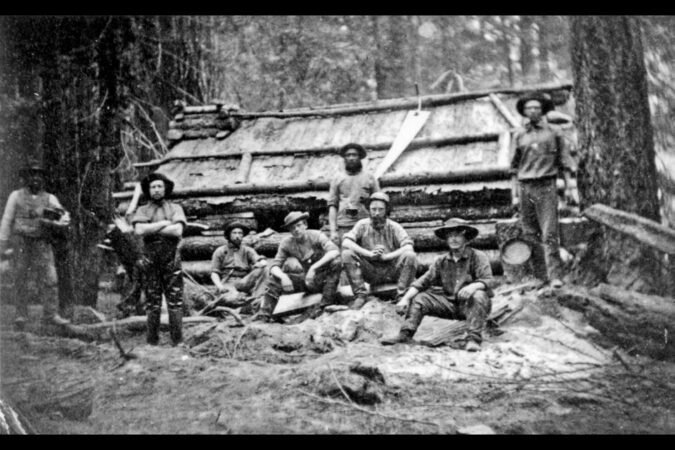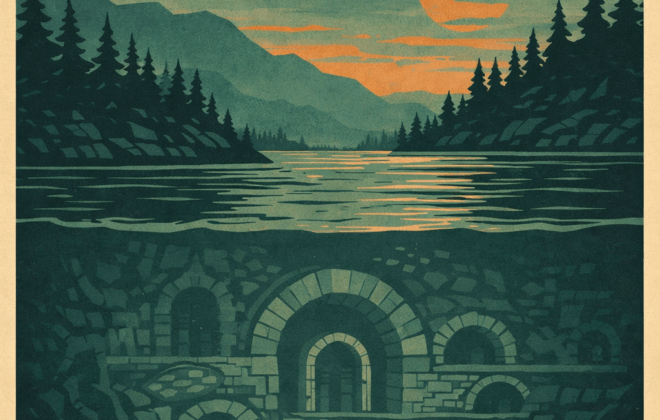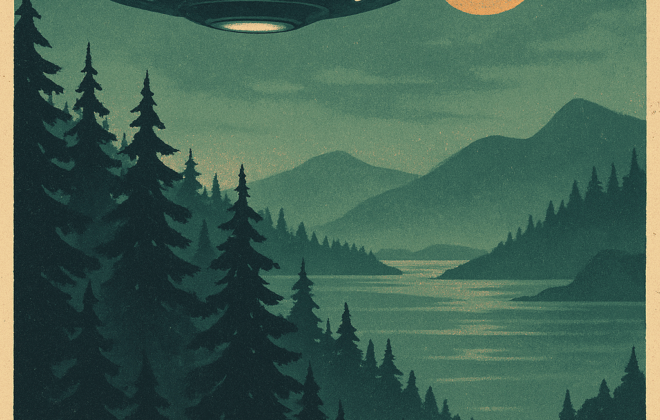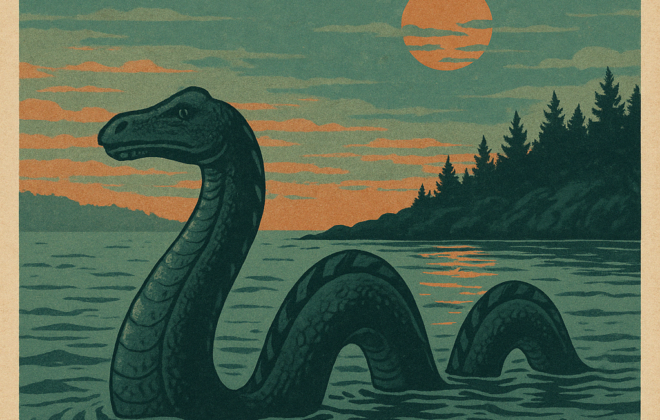Mysterious and Curious (Vol.1) – Vancouver Island’s Lost Caves of Gold
Mysterious and Curious is a blog that retells legendary history and folklore: curious people, places and things in Beautiful British Colombia. For our first volume, we are diving into a tale that includes lost caves, a buried boot full of gold nuggets, carved steps into a rock gallery and a lost bronze Spanish cannon. Strap in for:
The tale of Vancouver Island’s Leech River and the Lost Caves of Gold.
Leechtown is at the confluence of the Leech River into the Sooke River in southern Vancouver Island, British Columbia. The town is about 59 kilometres northwest of Victoria. While no buildings exist today, there is a ghost townsite and rumoured hidden treasure somewhere to be found nearby.

Leechtown was ultimately named after Peter John Leech, who discovered the area. Leech was part of the Vancouver Island Exploring Expedition, which explored the Sooke River tributary, then called the Leech River.
In 1864 prospectors flooded the area looking for gold. Leechtown had six general stores, three hotels, and 30 saloons within months. There were over 1200 prospectors, and at its peak, there was a population of 4000 people in Leechtown.

The legends of treasure that are associated with this area are as follows:
The Golden Boot
In 1855 or 1856, Richard Barter, a Canadian, known as Rattlesnake Dick, and his gang robbed a Wells Fargo mule train in California of about $80,000 in gold. Rattlesnake set up camp on the banks of the Leech River, escaping California, the story goes a few ways, but he smelted down his gold (worth at the time $40,000) into nuggets and claimed he found it in the area. In 1859, Californian law enforcement fatally shot him. On or before his death bed, he indicated the gold was buried 150 yards, or feet, or 250 yards, or feet, northwest from the northwest corner of the largest building in Leechtown. Allegedly, he found his way to Leechtown to slowly launder the gold he kept hidden in a knee-high leather boot. The knee-high leather boot was buried with a cooking pot over the top about 18 inches underground. Today that boot of nuggets is worth well over 3 million dollars.
Hans Christen’s Cave
One of the original prospectors was a Swedish man by the name of Hans Christen. Hans was a trained geologist with a degree from the University of Copenhagen and set up his camp at the base of Survey Mountain. A violent storm blew in after establishing his base camp, panicking his pack mule. The panicked mule broke free from its tether and fled into the night. The following morning, Christen set out to find his missing mule. He found the scared mule hiding in a small cave, and upon examination of the cave, he found a vein of gold 24 inches wide extending into the cave. Now there are two ways this story has been told: Christen went on a drinking binge in celebration of his discovery. When he finally sobered up, he could not remember the cave’s location. The other being: On his way back, he slipped, fell, hit his head, and ended up unconscious. When he regained consciousness, he set out to find the cave again but could not find it. Hans spent the next year trying to find the cave location but was unsuccessful. He died of tuberculosis in a Victoria rest home in late 1865. Today, the cave still remains a mystery.
Ed Mullard’s Cave
In an unknown year, while hunting in the Jordan Meadows-Leechtown area, Ed Mullard discovered a cave in the rock comprising chiselled steps, multiple galleries and treasures. One account has Mullard alone; another includes a man named McLaren, but only Mullard entered the cave. The discovery of a cave in the area in 1928 may have inspired the tale.
In April 1959, Mullard told his story to reporter Ted Harris but died at 56 before he could show Harris the place. The following year, the newspaper organized a fruitless search to locate the cave using information Mullard provided and aerial survey photos. One of the earliest accounts of Mullard’s discovery was published in the Sunday, September 21, 1969, edition of The Daily Colonist by T.W. Paterson. The following is an excerpt of the story according to the newspaper:
“Late one afternoon, Mullard had left his partner to hunt deer. Finding a fresh track, he followed his prey through the undergrowth. Night descends rapidly in autumn, however, and dusk ended the hunt prematurely. Heading back to camp, Mullard elbowed his way through chest-high salal. Suddenly, the prospector made a startling discovery – he was descending a staircase in the brush. Shouldering aside the salal for a better view in the failing light, Mullard found himself facing an oblong hole in the cliffside. Upon peering into its murky depths, he could see another series of steps, seven in number. Beyond was an arch and a rectangular gallery about 10 feet in length and high enough for a man to stand upright (Mullard stood around six feet tall). Overcome by curiosity, in the feeble glow of matches, Mullard inched along the silent passage, down the second staircase, and into the gallery. At its far end, in the right wall, the scene was repeated: another arch, seven more steps and a second gallery. Here, however, Mullard encountered water shin-deep. Beyond the dancing pale of his match, he detected what appeared to be yet another gallery. But instead of exploring further, he retreated to the entrance, memorized his location, and hastened back to camp. He did not live to see the mystery shaft again, and, as far as is known, no other man has set eyes on it.”
Sources differ considerably on what happened next (in fact, sources vary on just about every aspect of this story, as is the case with all great treasure mysteries); some say that while exploring the man-made galleries, he found: tools, weapons and artifacts that may have been Spanish in origin, or that he found one or more gold ingots. (gold bars)
Some say he found nothing at all. Upon hearing Harris’ story, the Colonist had agreed to sponsor an official expedition based on seven clues that Harris had gleaned from his conversations with Mullard:
1. The area was between Leechtown and Jordan Meadows.
2. It is somewhere along a shorter route than the regular trail between the two because Mullard spoke of a shortcut home.
3. It is at the foot of huge rock bluffs.
4. It is on ground that isn’t very steep, for the opening is almost horizontal.
5. It is among heavy undergrowth on shallow soil, for it was overgrown although cut into granite.
6. It is a substantial distance from Leechtown, for Mullard spoke of hoping to get to the site and out again in one day but being prepared for a two-day trip, just in case.
7. It is in high country, for he mentioned it is overlooking Jordan Meadows.
Vancouver Island is rich in legends about an early Spanish occupation. Here are a few more bits of information possibly connected to the lost tunnel:
Jordan Meadows is reputedly home to a mystery bronze cannon (some sources say a Spanish bronze cannon) that has been seen many times by hunters and prospectors travelling through the area, none of whom were ever able to relocate it when they wanted to show it to somebody or attempt to salvage it.
A legend similar to the above cannon story is the bronze tablet or plaque seen in the same area many times, attached to, or through growth, become part of, a tree. Again, those who have seen this bronze tablet or plaque can never relocate it.
Rumours that a Spanish monastery existed in the area have persisted for many years. Some have linked the tunnel to the monastery legend, that it may have been the monastery (or, at least, a part of it), or that those that built the rumoured monastery were also responsible for carving the tunnel.
All that is unknown is waiting to be discovered. Happy exploring, and until next time, if you have more to add to this Mysterious and Curious article or another topic you would like to share, feel free to contact us at [email protected]
Sources:
https://bcgoldadventures.com/leech-river-and-the-lost-cave-of-gold/
https://www.bcprospectors.ca/Mullard.htm
http://lostmines.net/leechtown-bc.html
https://en.wikipedia.org/wiki/Leechtown,_British_Columbia
https://www.thenav.ca/2018/12/13/the-legend-of-leechtowns-golden-boot/
*exploring these areas are not for the inexperienced. There are many dangers to consider, so we do not recommend exploring without the right expertise, equipment and group size.






